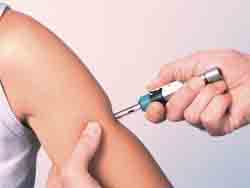Communicable diseases
Sakshi Education
Communicable diseases are those that affect people by coming in contact with the infected person or the surfaces/objects contaminated by the virus or bacteria. The virus/bacteria could pass through air or consumption of contaminated food or contact with body fluids. The following list includes major ones among the various communicable diseases.


Ebola
Flu
HIV – AIDS
Pertussis
Rabies
Tuberculosis (TB)
Global Health Topics Hepatitis 
Polio
Malaria
Sexually Transmitted Diseases (STDs)
Chlamydia
Syphilis
- The full name of Ebola is Ebola Virus Disease ( EVD)
- It is categorized under the deadly Viral RNA category.
- Virus is spread by direct contact with an infected person or the recently contaminated body fluids.
- Symptoms include sore throat, muscle pain, diarrhoea, measles-like rash, reduced liver and kidney function, vomiting etc
- There is no cure or vaccine available for Ebola yet. Intensive care at the preliminary stage is only chance of surviving the disease.
Flu
- Influenza or Flu is respiratory infection that generally affects the areas of nose, throat and lungs.
- Major symptoms are headache, weakness, muscle pains, runny nose and sore throat.
- It is caused by Influenza virus; there are three types of Influenza virus categorized as A, B and C.
- This virus mainly spreads through air while infected people sneeze or cough.
- There are mild or deadly levels of influenza, vaccines are available to fight such situations.
HIV – AIDS
- Acquired Immuno deficiency Syndrome aka AIDS is one of the deadliest among communicable diseases.
- It is caused by Human Immuno deficiency Virus which causes the gradual degradation of the immune system.
- It is mostly transmitted through sexual contact, contaminated blood transfusion or from mother to child through breast feeding.
- Symptoms may include various kinds of infections all at once as the patient’s body becomes weak.
- It leads to inevitable death of the patient with him/her becoming vulnerable to other disease conditions like TB.
- It is treated with HAART (highly active antiretroviral therapy), a combination of anti- HIV components will not cure the disease, but help the patient cope with the disease.
Pertussis
- Pertussis or whooping cough is a contagious disease spread by Bordetella Pertussis.
- The bacteria affects respiratory system causing severe coughs
- The condition is usually treated with antibiotics to reduce the severity of the cough.
- Children are particularly sensitive to this disease
- Vaccinations are available to help prevent Pertussis
Rabies
- Rabies is a serious condition that affects the central nervous system
- It is caused by Rabies Virus
- The symptoms of Rabies includes anxiety, confusion, excessive saliva production , hallucinations, high level of excitement, insomnia, problems swallowing due to painful throat and voice box ,spasms, restlessness
- It usually spread through the bite or scratches from an infected animal or human which helps virus comes into contact with the blood stream or muccus system
- Death may occur within 3 to 10 days after the beginning fo symptoms.
- Prevention is through vaccines and the process of post-exposure prophylaxis.
Tuberculosis (TB)
- Tuberculosis is a disease that most often comes with malnutrition.
- It is caused by bacteria called Mycobacterium Tuberculosis
- The bacteria may attack lungs, kidney, spine or brain and all of them are equally fatal.
- Chronic coughs and blood in phlegm are the major symptoms associated with TB
- It spreads from through personal contact with infected person and the treatment of TB takes a long period of time.
Global Health Topics Hepatitis

- Hepatitis is an inflammation of the liver, most commonly caused by a viral infection.
- There are five main hepatitis viruses, referred to as types A, B, C, D and E.
- The symptoms include nausea, abdominal pain, fatigue, malaise, and jaundice.
Polio
- Polio is the short form of Poliomyelitis a disease which attacks the nervous system.
- There are three kinds of viruses broadly known as polioviruses which causes the disease
- Polio generally affects children under five causing dysfunction of limbs or muscles and similar conditions
- In aggravated conditions it can reach the stage of paralysis
- There is no cure for the disease so importance is given to prevention.
Malaria
- Malaria is an infectious disease that transmits through anopheles mosquitoes
- It is caused by Plasmodium parasite
- Typical symptoms include fever, fatigue, vomiting and headaches
- Various treatments are available for Malaria depending on the severity and type of the disease
- Effective vaccine has not been found for malaria yet. Prevention from mosquito bites is generally advised.
Sexually Transmitted Diseases (STDs)
Chlamydia
- Chlamydia is an infection caused by bacteria called Chlamydia trachomatis.
- In women, it causes Pelvic inflammation and pain which may or may not lead to infertility.
- In men, it may occur as urethral infection or swollen testicles.
- It can be treated with minimal care and is not a grave situation.
Syphilis
- Syphilis can be a serious condition if not treated with antibiotics.
- It is caused by bacteria called Treponema pallidum.
- Symptoms include ulcers, fever, fatigue etc.
- Left for long it can lead to conditions like mental illness, blindness and eventually death.
Published date : 31 Jan 2015 06:18PM













